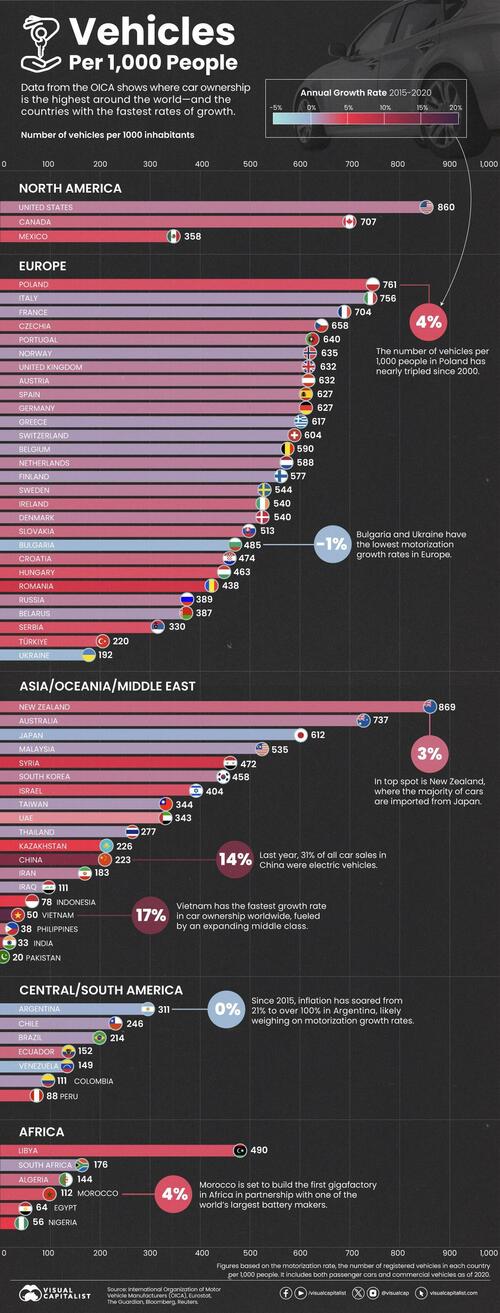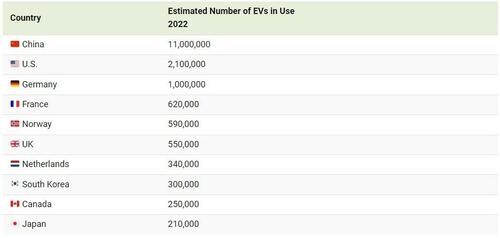In 2020, there were 289 million vehicles in use in America, or about 18% of the global total.
With one of the largest car ownership rates worldwide, the number of U.S. cars on the road have more than doubled since the 1960s. But how does ownership compare to other countries, and who is seeing the fastest growth rates amid a rising global middle class?
This graphic, via Visual Capitalist’s Dorothy Neufeld, shows vehicles per capita by country, based on data from the International Organization of Motor Vehicle Manufacturers (OICA).

Highest Car Ownership Rates Worldwide
Below, we rank countries based on the number of registered vehicles in use per 1,000 people, including both passenger cars and commercial vehicles as of 2020:
| Country | Number of Vehicles in Use per 1000 Inhabitants | Average Annual Growth Rate 2015-2020 |
|---|---|---|
| 🇳🇿 New Zealand | 869 | 3% |
| 🇺🇸 U.S. | 860 | 2% |
| 🇵🇱 Poland | 761 | 4% |
| 🇮🇹 Italy | 756 | 1% |
| 🇦🇺 Australia | 737 | 2% |
| 🇨🇦 Canada | 707 | 3% |
| 🇫🇷 France | 704 | 1% |
| 🇨🇿 Czechia | 658 | 3% |
| 🇵🇹 Portugal | 640 | 2% |
| 🇳🇴 Norway | 635 | 1% |
| 🇦🇹 Austria | 632 | 2% |
| 🇬🇧 UK | 632 | 2% |
| 🇩🇪 Germany | 627 | 2% |
| 🇪🇸 Spain | 627 | 2% |
| 🇬🇷 Greece | 617 | 1% |
| 🇯🇵 Japan | 612 | 0% |
| 🇨🇭 Switzerland | 604 | 1% |
| 🇧🇪 Belgium | 590 | 1% |
| 🇳🇱 Netherlands | 588 | 2% |
| 🇫🇮 Finland | 577 | 1% |
| 🇸🇪 Sweden | 544 | 1% |
| 🇩🇰 Denmark | 540 | 2% |
| 🇮🇪 Ireland | 540 | 3% |
| 🇲🇾 Malaysia | 535 | 6% |
| 🇸🇰 Slovakia | 513 | 3% |
| 🇱🇾 Libya | 490 | 4% |
| 🇧🇬 Bulgaria | 485 | -1% |
| 🇭🇷 Croatia | 474 | 3% |
| 🇸🇾 Syria | 472 | 7% |
| 🇭🇺 Hungary | 463 | 4% |
| 🇰🇷 South Korea | 458 | 2% |
| 🇷🇴 Romania | 438 | 7% |
| 🇮🇱 Israel | 404 | 4% |
| 🇷🇺 Russia | 389 | 2% |
| 🇧🇾 Belarus | 387 | 1% |
| 🇲🇽 Mexico | 358 | 4% |
| 🇹🇼 Taiwan | 344 | 1% |
| 🇦🇪 UAE | 343 | 8% |
| 🇷🇸 Serbia | 330 | 4% |
| 🇦🇷 Argentina | 311 | 0% |
| 🇹🇭 Thailand | 277 | 5% |
| 🇨🇱 Chile | 246 | 1% |
| 🇰🇿 Kazakhstan | 226 | -1% |
| 🇨🇳 China | 223 | 14% |
| 🇹🇷 Türkiye | 220 | 4% |
| 🇧🇷 Brazil | 214 | 1% |
| 🇺🇦 Ukraine | 192 | -1% |
| 🇮🇷 Iran | 183 | 2% |
| 🇿🇦 South Africa | 176 | 1% |
| 🇪🇨 Ecuador | 152 | 3% |
| 🇻🇪 Venezuela | 149 | -1% |
| 🇩🇿 Algeria | 144 | 3% |
| 🇲🇦 Morocco | 112 | 4% |
| 🇨🇴 Colombia | 111 | 1% |
| 🇮🇶 Iraq | 111 | 4% |
| 🇵🇪 Peru | 88 | 4% |
| 🇮🇩 Indonesia | 78 | 5% |
| 🇪🇬 Egypt | 64 | 4% |
| 🇳🇬 Nigeria | 56 | 5% |
| 🇻🇳 Vietnam | 50 | 17% |
| 🇵🇭 Philippines | 38 | 3% |
| 🇮🇳 India | 33 | 10% |
| 🇵🇰 Pakistan | 20 | 7% |
Clinching top spot is New Zealand, a country known for its love of cars.
With nearly nine cars on the road to every 10 people, this figure is notably high considering that children make up about 20% of the population. The majority of cars are imported second hand from Japan thanks to a wave of deregulation in the 1980s along with the country being a major producer of right-hand drive cars.
The U.S. falls close behind, with a clear preference for trucks and SUVs. In fact, the Ford F-1 Series has been the best-selling vehicle in America for 42 consecutive years.
In Europe, Poland has the highest number of vehicles per person, but one of the lowest share of electric vehicles (EVs). While EVs make up nearly 16% of all cars in top-ranking country Norway, they comprise 0.1% in Poland. On average, EVs account for 0.8% of passenger cars in the European Union.
Driven by an expanding middle class, Vietnam has seen the fastest growth in ownership. Between 2015 and 2020, the motorization rate grew by an astonishing 17% each year. Additionally, China witnessed 14% growth while India’s vehicles per 1,000 people increased 10% annually over the period.
The Top EV Markets, by Country
As EV sales gain momentum, here are the biggest markets worldwide, based on the number of all-EV cars in use as of 2022:

Source: IEA Global EV Outlook 2023
China is home to over half of the world’s EVs.
Its foothold on the global EV market can be explained by its close proximity to the raw materials used in EV batteries. In fact, China produces roughly 70% of the world’s rare earth metals and has more battery production capacity than all other countries combined.
Adding to this, China developed key government policies that specifically tackled operational hurdles, such as battery constraints, leading to innovation in core technologies. In 2023, EVs made up 31% of all car sales in China, boosted by government incentives and strong consumer demand.
Norway is another leader in the EV market, whose government began introducing EV policies as early as 1990. By 2025, the country aims to phase out internal combustion engine vehicle sales completely. About 80% of all vehicles sales in Norway were EVs in 2022, the highest in the world.















